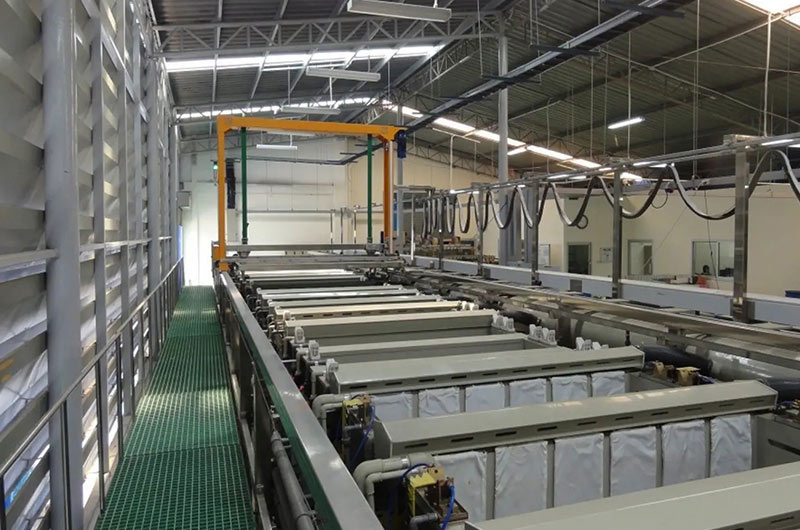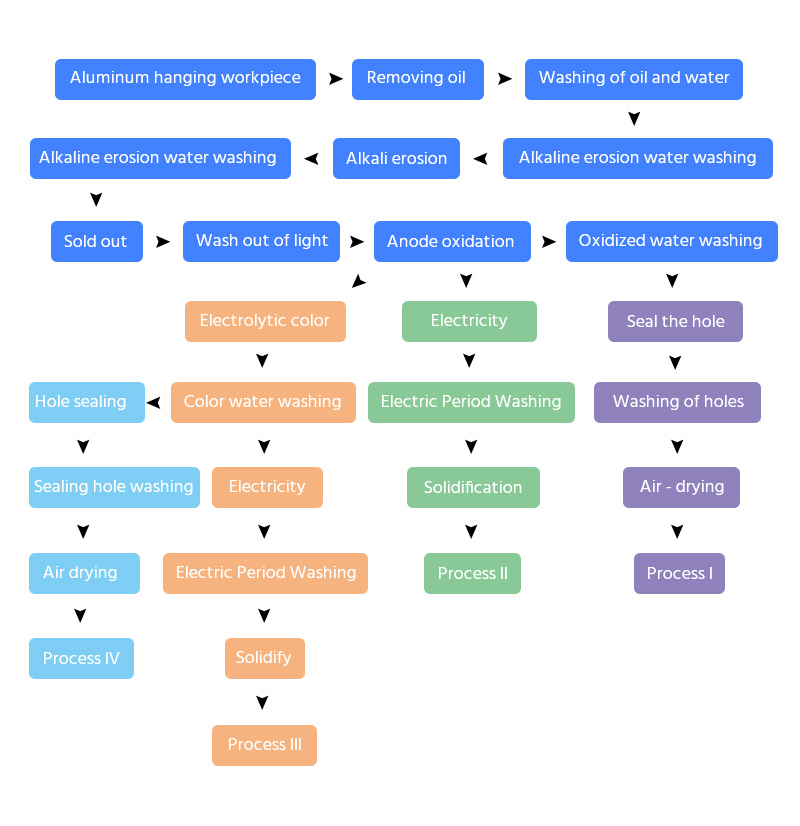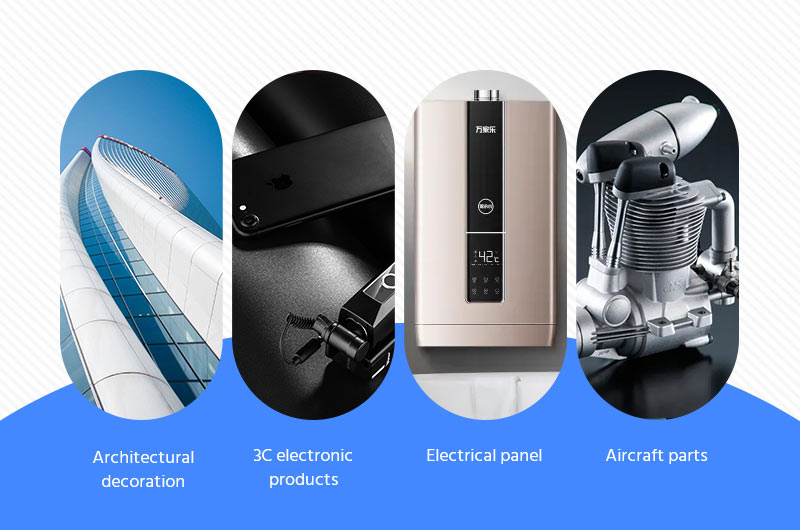What is anodizing of aluminum?
The anodizing process of aluminum and aluminum alloy is a process that uses aluminum or aluminum alloy products as anodes, places them in electrolyte solution for electrification, and then uses electrolysis to form aluminum oxide film on their surfaces. After anodizing treatment, aluminum surface can generate several microns to hundreds of microns of anodized film. Compared with the natural oxide film of aluminum alloy, its corrosion resistance, wear resistance and decorative properties have been significantly improved.

Why is anodizing of aluminum essential?
In order to overcome the defects in the surface hardness and wear resistance of aluminum alloys, expand the scope of application and prolong the service life, the surface treatment technology is indispensable in the use of aluminum alloys, and the anodic oxidation is the most widely used and successful technology.
Anodized metal aluminum films can change the surface state and properties, such as surface coloring, improving corrosion resistance, enhancing wear resistance and hardness, and protecting metal surfaces. Because of these special properties, it has been widely used in all aspects.
What is the principle of aluminum anodizing?
The principle of aluminum anodizing is essentially the principle of water electrolysis.
Aluminum and its alloys are placed in the corresponding electrolyte (such as sulfuric acid, chromic acid, oxalic acid, etc.) as anodes for electrolysis under specific conditions and under the action of impressed current. Aluminum or its alloy of the anode is anodized, and a thin layer of aluminum anodizing is formed on the surface, with a thickness of 5-30 microns, and a hard anodized film of 25-150 microns.

The anodized aluminum or its alloy has improved its hardness and wear resistance, which can reach 250~500 kg/mm2. It has good heat resistance, the melting point of the hard anodized film is up to 2320K. It has excellent insulation, and the breakdown resistance voltage is up to 2000V. It has enhanced the corrosion resistance, and will not be corroded after thousands of hours in the ω= 0.03 NaCl salt spray.
There are a lot of micropores in the thin anodizing film, which can absorb various lubricants, and is suitable for manufacturing engine cylinders or other wear-resistant parts. The membrane has strong microporous adsorption capacity and can be colored into various beautiful colors. Nonferrous metals or their alloys (such as aluminum, magnesium and their alloys) can be anodized. This method is widely used in mechanical parts, aircraft and automobile parts, precision instruments and radio equipment, daily necessities and architectural decoration.

What are the performance characteristics of anodization?
Improve Corrosion Resistance
Aluminum anodized film can effectively protect the aluminum substrate from corrosion. The anodic anodizing film obviously has better performance than the naturally formed oxide film. The film thickness and sealing quality directly affect its corrosion resistance.
Strong protection-decorative effect
The aluminum anodizing film can protect the metallic luster of the polished surface. The anodizing film can also be dyed and colored to obtain and maintain a colorful appearance.

Improve hardness and wear resistance
Thick and hard Al2O3 film can be obtained on the surface of aluminum and aluminum alloy by hard anodizing. This kind of film has not only high hardness and thickness, but also low roughness. In sulfuric acid or oxalic acid solution, hard and thick anodizing film can also be obtained on aluminum products by anodizing.
The porous thick anodized film can store lubricating oil, so it can be effectively applied to aluminum products working in friction state. For example, after anodizing of engine cylinders and pistons of automobiles and tractors, their wear resistance can be greatly improved.
As an electrical insulating layer
The anodized film obtained from anodizing aluminum and aluminum alloy products has a large resistance, so it has a certain role in improving the electrical insulation of some products. The dielectric layer of capacitors can be prepared by anodizing, or the insulating layer can be prepared by using aluminum anodized as its surface.
As the bottom layer of painting
Because of its porosity and good adsorption capacity, the anodizing film can be used as the bottom layer of paint spraying and other organic films, so that the paint film and organic film can be firmly combined with the products, thus increasing its corrosion resistance.
As the bottom layer of electroplating
Before electroplating aluminum and aluminum alloy products, the bottom layer must be applied to them before electroplating. Aluminum anodizing film is a method of accepting organic coating and electroplated coating on aluminum surface, which effectively improves the adhesion and corrosion resistance of the surface layer.
Strong scratch resistance
The anodized aluminum is not easy to scratch and bump, the surface is clean and tidy, and the service life is long.
High fire resistance
The anodized surface of aluminum is free of paint and any chemical substances, does not burn at 600 ℃, and does not produce toxic substances. It meets the environmental requirements.
Strong metal sense
After anodizing, the aluminum surface has high hardness, no paint covering on the surface, retains the metal color of aluminum, highlights the modern metal feeling, and improves the product grade and added value.
Strong stain resistance
Easy to clean, simple maintenance, no fingerprints on the surface, easy to clean, no corrosion spots.
Good processability
The anodized aluminum has strong decorative property and moderate strength. It can be bent and formed, and can be pressed at high speed. It is convenient to directly process into products without complex surface treatment, which shortens the production cycle and reduces the production cost of products.
What is the difference between aluminum anodized and chemical conductive anodized of aluminum?
- Anodizing is carried out under the condition of high voltage, which is an electrochemical reaction process; While aluminum chemical conductive anodized does not require electricity, it only needs to be immersed in liquid medicine. It is a pure chemical reaction.
- Anodic anodizing takes a long time, usually tens of minutes, while conductive anodized takes only tens of seconds.
- The film formed by anodic anodizing has several microns to dozens of microns, and is hard and wear-resistant; The film formed by conductive anodized is only 0.01-0.15 μ m, and the wear resistance is not very good, but it also has some advantages, such as it can conduct electricity and resist atmospheric corrosion.
- The anodized film is originally non-conductive, but because the film formed by conductive anodizing is very thin, it is conductive.
The application of aluminum anodizing

- Anti static workbench and frame on the assembly line.
- Building decoration materials such as curtain walls, buildings, offices, shopping malls, metal ceilings, etc.
- 3C electronic products such as mobile phone case and computer case.
- Household appliances and furniture, such as electrical panel, cabinet panel, refrigerator panel, furniture panel, etc.
- Aluminum anodizing is also widely used in mechanical parts, aircraft and automobile parts, precision instruments and radio equipment, machine shells, lamps and lighting, handicrafts, interior decoration, signs, automobile decoration and other industries.